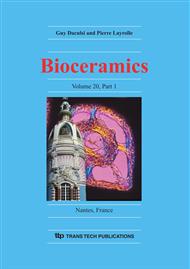p.1249
p.1253
p.1257
p.1261
p.1265
p.1269
p.1273
p.1277
p.1283
Hybrid Chitosan Membranes Tested in Sheep for Guided Tissue Regeneration
Abstract:
Previous in vitro studies confirmed an improved cytocompatibility of chitosan-silicate hybrid membranes over chitosan membranes. The main goal of this study was to assess the in vivo histocompatibility of both membranes through subcutaneous implantations at different time periods, 1 week, 1, 2 and 3 months, using a sheep model. Chitosan membranes elicited an exuberant inflammatory response and were consequently rejected. The hybrid chitosan membranes were not rejected and the degree of inflammatory response decreased gradually until the third month of implantation. Histological evaluation also showed that these membranes can be resorbed in vivo. This study demonstrates that the incorporation of silicate into the chitosan solution improves its histocompatibility, indicating that the hybrid chitosan-silicate membranes are suitable candidates to be used in clinical applications.
Info:
Periodical:
Pages:
1265-1268
Citation:
Online since:
November 2007
Price:
Сopyright:
© 2008 Trans Tech Publications Ltd. All Rights Reserved
Share:
Citation:


